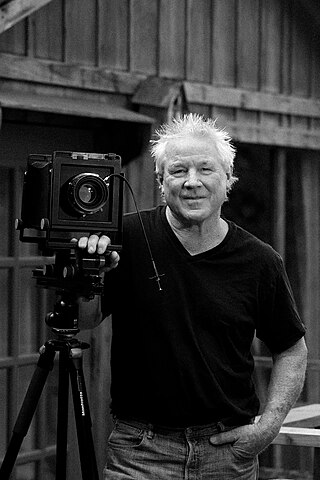
Henry Wessel was an American photographer and educator. He made "obdurately spare and often wry black-and-white pictures of vernacular scenes in the American West".

Kim Weston is an American photographer known for his fine art nude studies.

Jack Zajac is a Californian West Coast artist who has been concerned with the “Romantic Surrealist tradition”.

Grant Mudford, is an Australian photographer.
Jim Goldberg is an American artist and photographer, whose work reflects long-term, in-depth collaborations with neglected, ignored, or otherwise outside-the-mainstream populations.
Robert Glenn Ketchum is a pioneering conservation photographer, recognized by Audubon magazine as one of 100 people "who shaped the environmental movement in the 20th century.".
Graham Howe is a curator, writer, photo-historian, artist, and founder and CEO of Curatorial, Inc., a museum services organization supporting nonprofit traveling exhibitions. Curatorial Inc. manages the E.O. Hoppé Estate Collection and the Paul Outerbridge II Collection among others. Born in Sydney, Australia, Howe now resides in Los Angeles and London.
George Rose is an American photographer and writer whose career has included work for the National Football League, Rolling Stone, Time, Life, Newsweek, Sports Illustrated, USA Today and the Los Angeles Times. He spent 20 years in the California wine industry, holding prominent public relations positions while amassing a significant body of award-winning food and wine photography.
Juergen Nogai is a German architecture, art and documentary photographer.
Larry Sultan was an American photographer from the San Fernando Valley in California. He taught at the San Francisco Art Institute from 1978 to 1988 and at the California College of the Arts in San Francisco 1989 to 2009.
Yuichi Hibi is a Japanese fine art photographer currently living and working out of New York City.
Roger Camp is a photographer, poet and educator. Initially self-taught, he began photographing in earnest on a transcontinental bicycle trip he planned and executed at age 15 (1961). Accompanied by his twin brother, Roderic Ai Camp, the political scientist, they rode from Orange, California to Dayton, Ohio and the following year to Victoria, B.C., Canada. The trips are chronicled in a two-part article in The American Geographical Society's Focus.
Lise Sarfati is a French photographer and artist. She is noted for her photographs of elusive characters, often young, who resist any attempt to being pinned down. Her work particularly explores the instability of feminine identity. Most recently, Sarfati’s photographs have focused on the relationship between individuals and the urban landscape. She has extensively worked in Russia and the United States.

Kansuke Yamamoto was a Japanese photographer and poet. He was a prominent surrealist born in Nagoya, Japan.

James Prigoff was an American photographer, author, and lecturer focusing on public murals, graffiti, and spraycan art. He has traveled extensively throughout the world documenting these art forms, and his personal archive of 100,000 slides may well be the most comprehensive of any individual mural and graffiti documentarian.

Samuel Bolton Colburn was an experimental artist, evolving a modernist approach to landscape and genre scenes during the Depression era. In the 1930s California became known nationally for its Regionalist painters like Colburn, who depicted urban and rural views of native life. These artists’ preferred medium was watercolor and they worked quickly outdoors on location developing a painting style that was spontaneous, gestural and raw.

Douglas Busch is an American photographer, inventor, teacher, and architectural designer known for using the world's largest portable view cameras and negatives to produce the world's largest photographic contact prints. His photography encompasses an array of subjects, including landscapes, cityscapes, nudes, portraits, and color, and is in the collections of major institutions such as the J. Paul Getty Museum, the Smithsonian Institution, Los Angeles County Museum of Art, and the Museum of Contemporary Art in Los Angeles. Busch's imaginative architectural work and drought-tolerant landscape designs have attracted celebrity clientele and have been featured in the Los Angeles Times, Robb Report, Western Interiors and Design, Open House, and Distinctive Homes. His dedication to the principles of healthy design and sustainable building practices led him to launch pH Living: Healthy Housing Systems, with the goal of providing homes for people who suffer from environmental allergies and chemical sensitivities. He also developed a vertical herb and vegetable production system called Farm in a Box.
Anthony Hernandez is an American photographer who divides his time between Los Angeles, his birthplace, and Idaho. His photography has ranged from street photography to images of the built environment and other remains of civilization, particularly those discarded or abandoned elements that serve as evidence of human presence. He has spent most of his career photographing in Los Angeles and environs. "It is L.A.'s combination of beauty and brutality that has always intrigued Hernandez." La Biennale di Venezia said of Hernandez, "For the past three decades a prevalent question has troubled the photographer: how to picture the contemporary ruins of the city and the harsh impact of urban life on its less advantaged citizens?" His wife is the novelist Judith Freeman.
William Clift is an American photographer known for his black-and-white imagery of landscapes and of architectural subjects. Most of his work has been made in New Mexico, including Santa Fe where he has lived and worked since 1971, and of Mont Saint Michel in France, and St. Louis, MO.
Roland Charles was an African-American photographer and gallerist, best known for co-founding The Black Photographers of California and its associated exhibition space, the Black Gallery, in Los Angeles, among the first institutions by and for black photographers.








